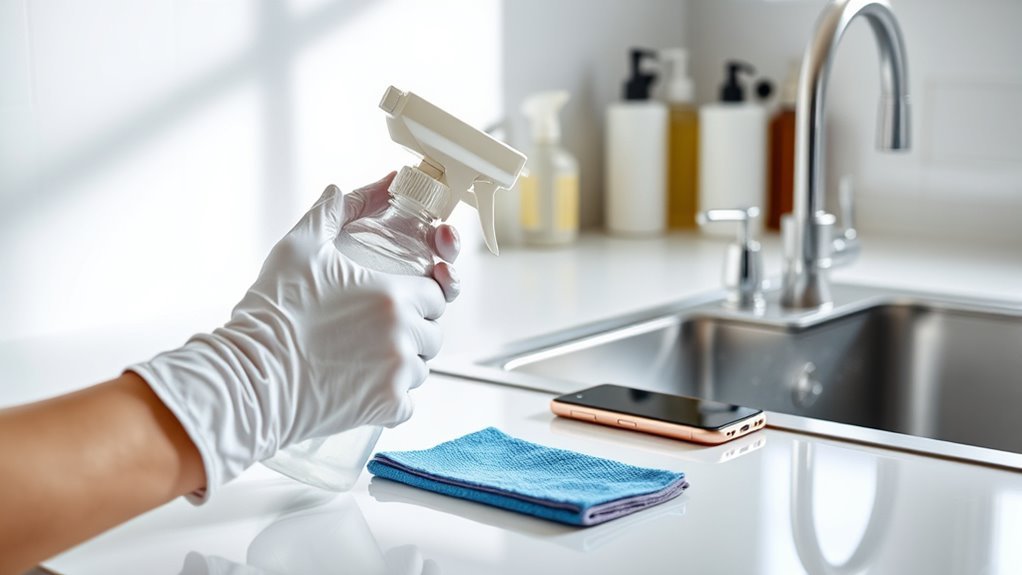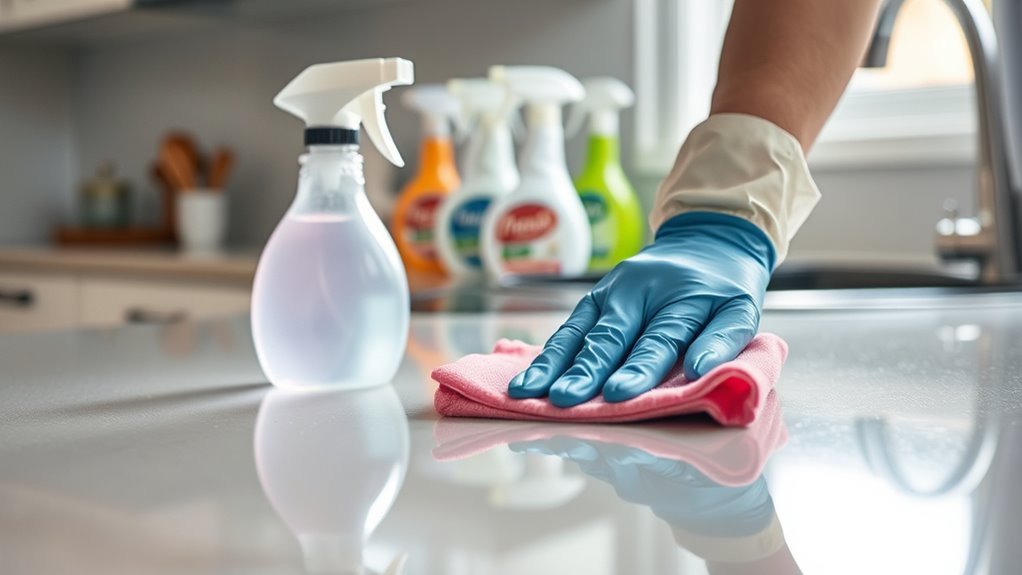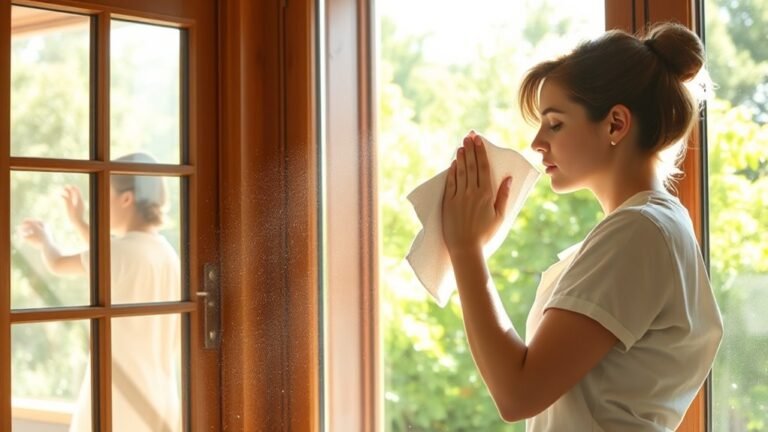How to Disinfect High-Touch Surfaces in Your Home
To disinfect high-touch surfaces like door handles, light switches, and countertops, start by choosing a disinfectant that’s safe for your surfaces—natural options like vinegar or hydrogen peroxide work well. Clean dirt off first, then apply an EPA-approved disinfectant and let it air dry for maximum effect. Don’t forget to wear gloves and ventilate your space for safety. Doing this daily helps keep germs away. Keep exploring for tips on maintaining a truly germ-free environment.
Identifying High-Touch Surfaces in Your Home

There are several high-touch surfaces in your home that you interact with daily, often without thinking. Identifying surfaces that serve as common hotspots is key to maintaining your freedom from germs. Think about the door handles you grab multiple times a day, the light switches you flick on and off, or the kitchen countertops where you prepare meals. Your phone, remote controls, and faucet handles are also part of this list. By focusing on these areas, you’re taking control of your environment, ensuring you’re not unknowingly exposing yourself or loved ones to harmful bacteria. Pinpointing these surfaces helps you prioritize your cleaning efforts, allowing you to confidently enjoy your home without feeling confined by unseen risks.
Choosing the Right Disinfectants for Different Surfaces
Once you’ve identified the high-touch surfaces in your home, the next step is picking the right disinfectants to keep those areas truly clean. You want products that not only kill germs but also respect the material they touch. That’s where surface compatibility comes in—using harsh chemicals on delicate surfaces can cause damage or discoloration. Natural disinfectants are a great option if you’re after freedom from strong chemicals and synthetic ingredients. Ingredients like vinegar, hydrogen peroxide, or essential oils can be effective while staying gentle on many surfaces. Just make sure to check each product’s compatibility with the material you’re treating, whether it’s wood, metal, or plastic. Choosing wisely means you protect both your health and your home’s integrity without sacrificing safety or effectiveness.
Step-by-Step Guide to Proper Disinfection

Before you start, make certain you have all the cleaning supplies ready. Remember, cleaning surfaces first helps remove dirt and grime before applying disinfectant. Then, apply the disinfectant as directed to guarantee effective germ-killing.
Gather Necessary Cleaning Supplies
You’ll need a few essential supplies to disinfect high-touch surfaces effectively. Choosing eco friendly options lets you protect your home without compromising the planet, while budget friendly supplies guarantee you’re not overspending. Here’s what to gather before you get started:
- Disinfectant spray or wipes that are EPA-approved and eco friendly
- Microfiber cloths or disposable paper towels for wiping surfaces
- Gloves to protect your hands and maintain hygiene
Clean Before Disinfecting
Gathering the right cleaning supplies sets you up for success, but taking the right steps to clean surfaces properly is just as important. Before you disinfect, focus on surface preparation by removing dirt, dust, and grime. Use effective cleaning techniques like wiping with soap and water or an all-purpose cleaner. This step guarantees disinfectants work better by eliminating barriers that reduce their efficiency. Don’t rush this process—thorough cleaning is the foundation of proper disinfection. Pay special attention to high-touch areas like doorknobs, light switches, and countertops. By mastering surface preparation, you maintain control over your environment and protect your freedom to live safely. Remember, a clean surface is the first step toward a truly disinfected home.
Apply Disinfectant Correctly
Three key steps will help you apply disinfectant effectively and keep your high-touch surfaces truly sanitized. First, surface preparation is essential—make sure you’ve cleaned the area thoroughly to remove dirt and grime, allowing the disinfectant to work properly. Then, focus on proper disinfectant application to maximize its impact. Here’s how:
- Use enough disinfectant to keep the surface visibly wet for the recommended contact time.
- Apply with a clean cloth, spray, or wipe, ensuring even coverage without over-saturating.
- Let the surface air dry naturally to avoid wiping away the disinfectant too soon.
Safety Tips When Using Cleaning Products

Although disinfecting high-touch surfaces is essential, handling cleaning products safely is just as important to protect yourself and others. To guarantee safe usage, always read and follow the product precautions on the label. Avoid mixing different cleaners, especially bleach and ammonia, as harmful fumes can form. Wear gloves and work in a well-ventilated area to minimize exposure to strong chemicals. Keep cleaning products out of reach of children and pets to prevent accidental ingestion or contact. After disinfecting, wash your hands thoroughly to remove any residue. By respecting these simple safety tips, you maintain your freedom to keep your home healthy without risking harm from the very products designed to protect you. Safety and cleanliness can go hand in hand when you handle products responsibly.
Frequency Recommendations for Disinfecting High-Touch Areas
You should disinfect high-touch surfaces daily to reduce the spread of germs and keep your space safe. In addition to daily cleaning, setting aside time for a weekly deep cleaning helps tackle areas that need extra attention. Sticking to this routine makes maintaining a healthy environment much easier.
Daily Disinfection Schedule
Establishing a daily disinfection schedule helps guarantee high-touch surfaces stay as clean as possible throughout the day. You’ll feel more in control and free when you stick to a simple daily checklist that targets the spots used most. Integrate this into your cleaning routine to keep germs at bay without feeling overwhelmed.
Focus on these high-touch areas daily:
- Door handles, light switches, and faucets, since everyone touches them regularly
- Electronic devices like phones, remotes, and keyboards, where germs linger
- Kitchen counters and dining tables, where food prep and eating happen
Weekly Deep Cleaning
While daily disinfection keeps high-touch surfaces clean, scheduling a weekly deep cleaning helps tackle areas where germs can build up over time. You’ll want to create weekly checklists to guide your cleaning routines, making sure no spot is missed—from door handles to light switches and remote controls. This approach not only refreshes your space but also gives you a clear structure without feeling overwhelmed. Treat these weekly sessions as a chance to reset, ensuring your home stays truly healthy without sacrificing your freedom or time. By sticking to a consistent plan, you maintain control over your environment with minimal effort. Remember, a little extra attention once a week goes a long way in keeping those high-touch surfaces safe and spotless.
Additional Tips to Maintain a Germ-Free Home
Although disinfecting high-touch surfaces is essential, keeping your home germ-free requires consistent habits beyond just cleaning. You can embrace natural alternatives like vinegar or hydrogen peroxide to disinfect safely without harsh chemicals, ensuring pet safety. Remember, your freedom to enjoy a healthy space comes from daily mindful actions.
Disinfecting is key, but daily mindful habits and natural solutions keep your home truly germ-free.
- Wash your hands frequently to reduce spreading germs throughout your home.
- Use washable covers on frequently touched items like remote controls or keyboards, cleaning them regularly.
- Keep your home well-ventilated to lower airborne bacteria and viruses.
Frequently Asked Questions
Can Natural Ingredients Like Vinegar Effectively Disinfect High-Touch Surfaces?
You might be surprised to learn about vinegar effectiveness as a disinfectant. While it’s a popular natural alternative, it doesn’t kill all germs, especially viruses like the flu or COVID-19. If you want freedom from harsh chemicals, vinegar can freshen and clean many surfaces but won’t fully disinfect high-touch areas. So, don’t rely solely on it—combine it with proven disinfectants to keep your home truly safe.
How Long Should Disinfectants Remain on Surfaces to Kill Viruses?
To guarantee disinfectant effectiveness, you’ll want to let the product stay wet on the surface for the recommended surface contact time, usually between 30 seconds to 10 minutes, depending on the disinfectant. Don’t rush wiping it off; that contact time is essential to kill viruses effectively. Check the label for specific instructions so you can confidently enjoy your space, knowing you’ve done a thorough job keeping things safe.
Are Disinfectant Wipes Safe to Use on Electronic Devices?
You can use disinfectant wipes on electronic devices, but you’ll want to check the label to verify they’re safe for screens and sensitive parts. Disinfectant wipe effectiveness depends on the ingredients, so choosing ones designed for electronics helps maintain electronic device safety without damage. Remember, don’t soak your device; just gently wipe it and let it air dry. This way, you keep your gadgets clean while preserving your freedom to use them worry-free.
Can Disinfecting Surfaces Prevent All Types of Infections?
You can’t rely on disinfecting surfaces alone to prevent all types of infections because disinfectant efficacy varies depending on the pathogen. While wiping down high-touch areas reduces infection transmission by killing many germs, some viruses and bacteria spread through the air or close contact, which surface cleaning won’t stop. To truly protect your freedom and health, combine disinfecting with good hand hygiene, ventilation, and staying mindful of your environment.
What Should I Do if My Skin Reacts to Disinfectants?
If your skin reacts to disinfectants, it’s likely due to skin sensitivity. You don’t have to put up with irritation—try switching to alternative disinfectants like natural sprays with vinegar or essential oils, which can be gentler. Always wear gloves when cleaning, and wash your hands thoroughly afterward. Listening to your body is key, so choose products that let you stay safe without sacrificing your comfort or freedom.






